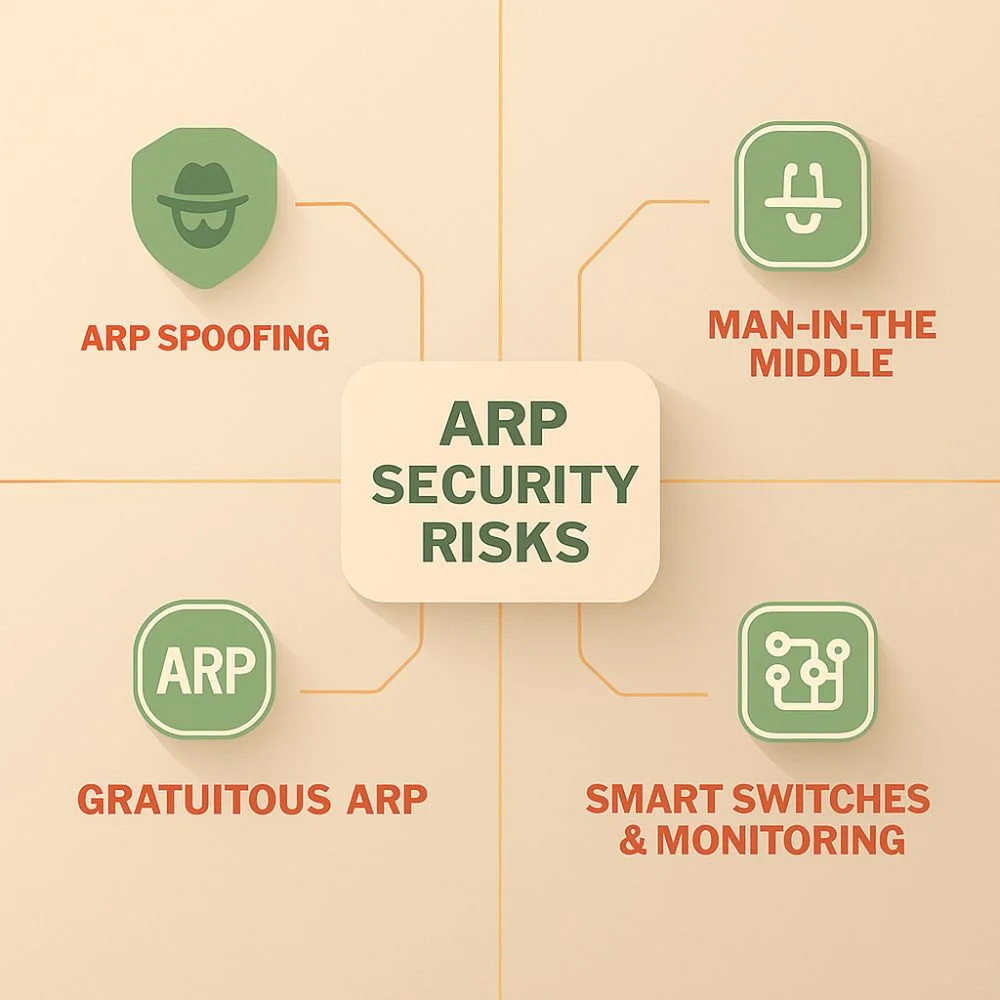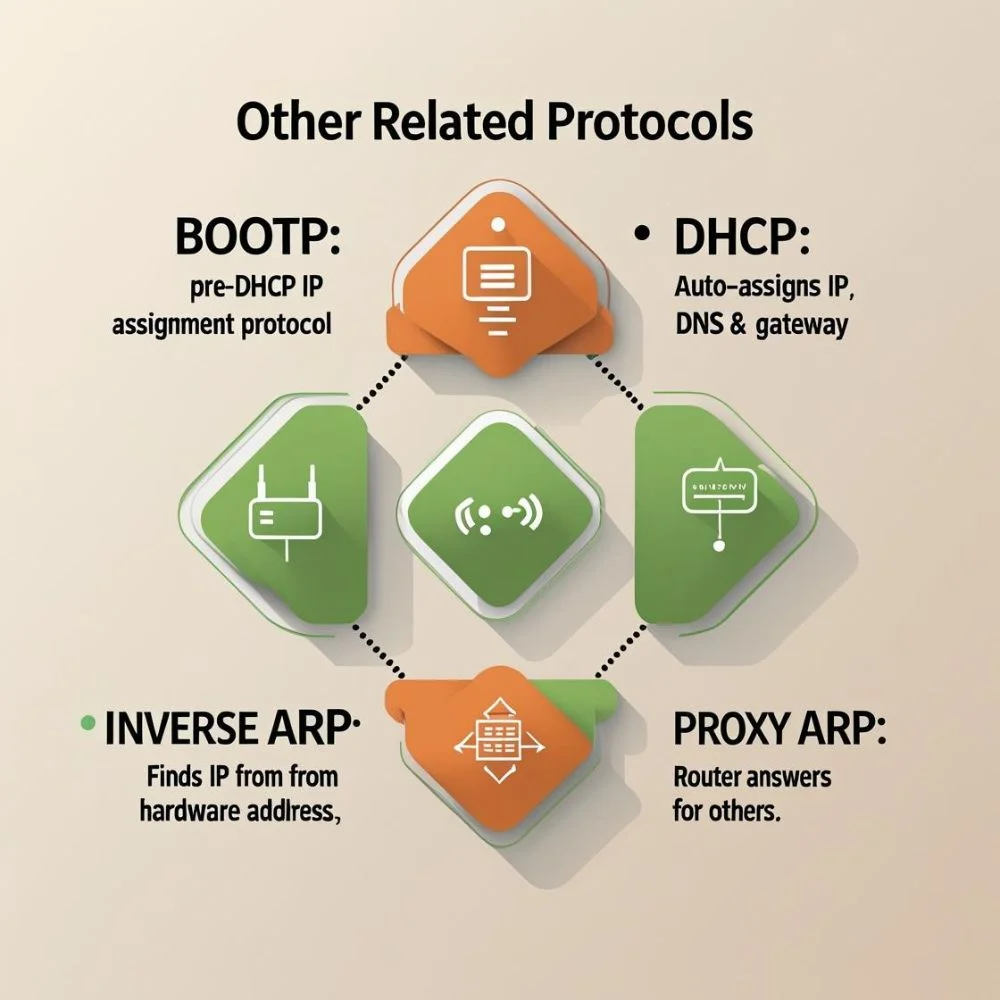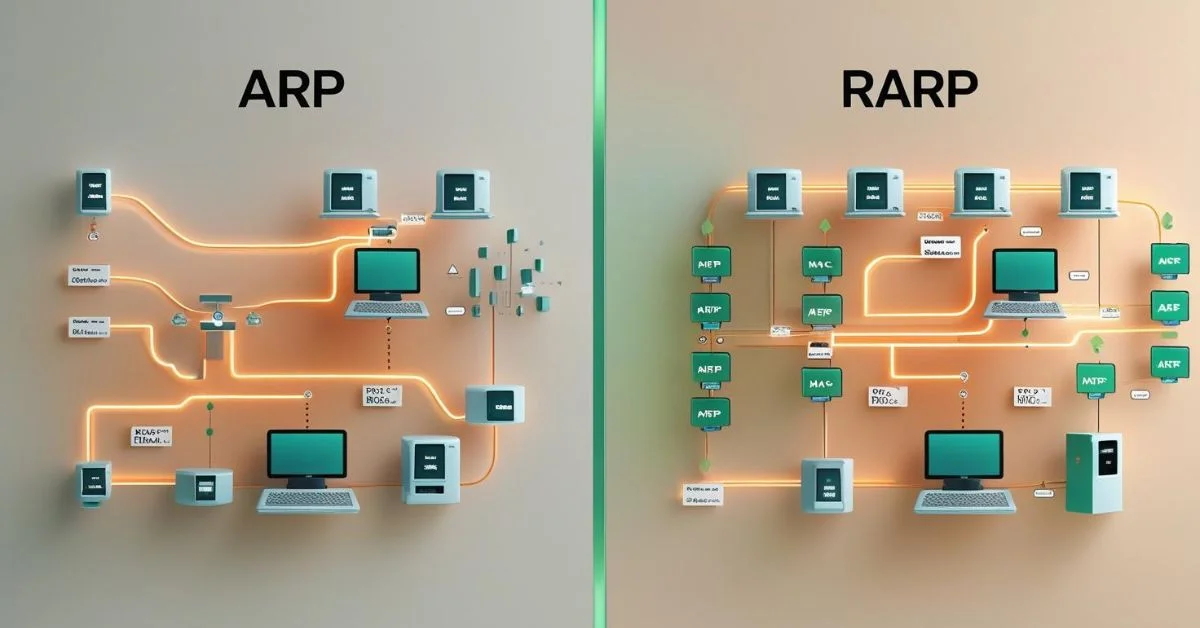In computer networks, devices need two types of addresses to communicate: a MAC address (physical address) and an IP address (logical address). Protocols like ARP and RARP help map one to the other. While ARP translates IP addresses into MAC addresses, RARP does the reverse it maps MAC addresses to IP addresses.
Understanding the difference between ARP and RARP is essential for grasping how data moves across a network, especially in local environments.
What Is ARP (Address Resolution Protocol)?
Definition and Purpose
ARP is a communication protocol used on local networks to find the physical address (also called the MAC address) of a device when you already know its IP address. It works behind the scenes whenever you visit a website, use your printer or share files over your home or office network.
How It Works (Simplified)?
Here’s how the ARP process usually works:
- Your computer wants to send data to another device on the network.
- It knows the IP address of that device but not the MAC address.
- It sends out an ARP request (a broadcast message) asking, “Who has this IP address?”
- The device with that IP replies, “I do, here is my MAC address.”
- Your computer stores this response in its ARP cache and uses it to send data directly.
Technical Capabilities and Benefits of ARP
- Used in IPv4 networks.
- Operates at Layer 2 and Layer 3 (Data Link and Network layers) of the OSI model.
- Uses broadcast to send requests and unicast to receive replies.
- Stores address in a temporary cache to improve performance.
- Works in nearly all operating systems including Windows, Linux and macOS.
Why ARP Is Still Important?
ARP is one of the foundational protocols of modern networking. Without it, devices would struggle to communicate efficiently. Whether you’re streaming a movie or accessing cloud services, ARP is quietly helping your data reach its destination.
What Is RARP (Reverse Address Resolution Protocol)?
Definition and Purpose
RARP does the opposite of ARP. It is used by a device to find out its own IP address when it only knows its MAC address. This was especially useful in the early days of networking when diskless computers (devices with no hard drive) couldn’t store IP address configurations.
How It Works (Simplified)?
- A device without an IP address sends a RARP request asking, “I’m this MAC address, what is my IP address?”
- A RARP server on the network looks up its database and replies with the IP address assigned to that MAC.
- The device uses this IP to communicate over the network.
Core Functions and Limitations of RARP
- Functions at the Data Link and Network layers.
- Requires a centralized RARP server to reply to requests.
- Mainly used by diskless workstations in legacy systems.
- Can only work within the same local area network (LAN).
- Offers only basic IP configuration (no gateway, DNS, etc.).
ARP vs RARP: The Main Differences
Here’s a side-by-side comparison to help you understand the difference between ARP and RARP more easily:
| Feature | ARP | RARP |
| Full Form | Address Resolution Protocol | Reverse Address Resolution Protocol |
| Direction | IP → MAC | MAC → IP |
| Use Case | Sending data when IP is known | Booting when only MAC is known |
| Usage Context | Common in today’s IPv4-based local and global networks | Previously used in early network setups with no built-in storage |
| Request Type | Broadcast | Broadcast |
| Response Type | Unicast | Unicast |
| Cache Support | Stores entries in ARP table | No built-in cache |
| Modern Relevance | Actively used in current networks | Outdated and no longer in use | Replaced by BOOTP and DHCP | |
| Requires Server? | No | Yes |
| Configuration Complexity | Simple and automatic | Manual configuration required |
Real-Life Example
Imagine you’re at a party and you know someone’s name (IP address), but you need their seat number (MAC address) to pass them a note. You ask the crowd, “Where is Sarah sitting?” That’s what ARP does, it helps you find Sarah’s seat number.
Now imagine you just arrived at the party and forgot your own seat number. You show your ID (MAC address) to the host and ask, “Where am I supposed to sit?” That’s RARP, you’re asking the network to assign you a location using your identity.
Why RARP Is No Longer Used?
RARP was once useful, but it had many limitations:
- It could only assign IP addresses no other critical info like subnet masks or DNS servers.
- Required a dedicated RARP server, which was hard to maintain.
- Couldn’t function across different networks (LAN only).
- Each mapping had to be set manually.
Over time, RARP was phased out and succeeded by protocols such as BOOTP and, more prominently, DHCP, which offer far more flexible network configuration. DHCP not only assigns IP addresses but also provides gateway, DNS, lease time and other configuration settings automatically. It’s faster, more efficient, and scalable.
Security Concerns with ARP
Although ARP is useful, it’s not secure by design. It trusts all devices on the network and doesn’t verify responses. This can lead to attacks like:

- ARP Spoofing: A hacker pretends to be another device to intercept data.
- Man-in-the-Middle Attacks: Attackers use false ARP replies to capture or alter traffic between two devices.
- Gratuitous ARP: A device announces its MAC-IP mapping even when no one asked, often used for redundancy or failover but can be abused.
For these reasons, modern enterprise networks use secure switches and network monitoring tools to detect and block suspicious ARP activity.
Other Related Protocols
To understand the evolution beyond ARP and RARP, here are a few related technologies:

- BOOTP (Bootstrap Protocol): Predecessor of DHCP, introduced more advanced IP assignment features.
- DHCP (Dynamic Host Configuration Protocol): Automatically assigns full network settings IP, gateway, DNS, etc.
- Inverse ARP, or in ARP, is typically used in technologies like Frame Relay and ATM, helping devices discover IP addresses when only the hardware address is available.
- Proxy ARP: When a router answers ARP requests for another device, common in complex networks or NAT setups.
Frequently Asked Questions (FAQ)
1. How do ARP and RARP differ from each other?
ARP helps find a device’s hardware address using its IP, while RARP does the opposite, it identifies the IP address when only the MAC is known. They serve opposite functions in a network.
2. Is ARP still used today?
Yes, ARP is still a critical protocol in IPv4-based networks. It allows devices to find each other within the same local network.
3. Why was RARP replaced?
RARP was limited to just IP address assignment and required manual configuration. It was replaced by DHCP, which is faster and more flexible.
4. Does ARP work in IPv6?
No. IPv6 uses a different method called Neighbor Discovery Protocol (NDP) to perform similar functions more securely.
5. How can I view the ARP table on my device?
- If you’re using Windows, you can check your ARP cache by opening Command Prompt and entering arp -a.
- On macOS/Linux: Use the command arp or ip neigh
Conclusion
What sets ARP and RARP apart is the way they handle address resolution, ARP looks up MAC addresses using IPs, while RARP goes the other way around. ARP is still widely used in modern networks to resolve IP addresses into MAC addresses, making device-to-device communication possible. RARP, on the other hand, served an important role in early networking but has since been replaced by more advanced protocols like DHCP.
Knowing how ARP and RARP function helps build a solid understanding of network communication. While ARP remains a backbone protocol in IPv4 networks, RARP now serves as a reference point in the evolution of network addressing technologies.



